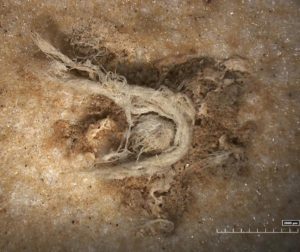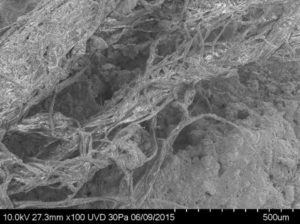
CNRS—Contrary to popular belief, Neanderthals may have been no less technologically advanced than Homo sapiens. An international team, including researchers from the CNRS, have discovered the first evidence of cord making, dating back more than 40,000 years (1), on a flint fragment from the prehistoric site of Abri du Maras in the south of France (2). Microscopic analysis showed that these remains had been intertwined, proof of their modification by humans. Photographs revealed three bundles of twisted fibers, plied together to create one cord. In addition, spectroscopic analysis revealed that these strands were made of cellulose, probably from coniferous trees. This discovery highlights unexpected cognitive abilities on the part of Neanderthals, suggesting they not only had a good understanding of the mathematics involved in winding the fibers, but also a thorough knowledge of tree growth. These results, published on 9 April 2020 in Scientific Reports, represent the oldest known proof of textile and cord technology to date.
___________________________

Photograph of the cord fragment taken by digital microscopy (the fragment is approximately 6.2 mm long and 0.5 mm wide). © C2RMF
___________________________

Detail of the cord fragment showing twisted fibers, observed by scanning electron microscopy. © MNHN
___________________________
Article Source: Edited from the CNRS news release
(1) Neanderthals lived between 350,000 and 28,000 years BC.
(2) Archaeological site in southeastern France (Ardèche). The team led by Marie-Hélène Moncel has previously shown that Neanderthals occupied this shelter.
The following laboratories contributed to this work: Histoire naturelle de l’Homme préhistorique (CNRS/Muséum national d’Histoire naturelle/Université de Perpignan Via Domitia), De la molécule aux nano-objets : réactivité, interactions et spectroscopies (CNRS/Sorbonne Université), along with the Centre de recherche et de restauration des musées de France (ministère de la Culture).
The excavations at the Abri du Maras have in particular benefited from funding from the French Ministry of Culture and the Auvergne-Rhône-Alpes Regional Archaeology Service.
___________________________
Advertisement



